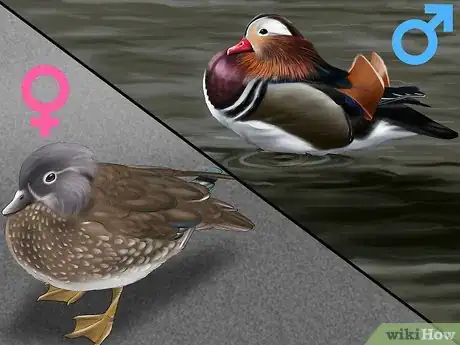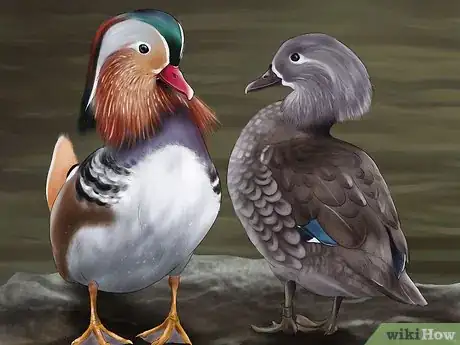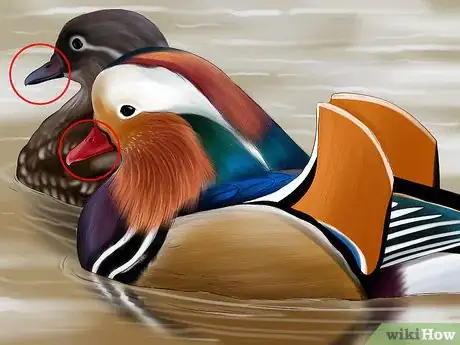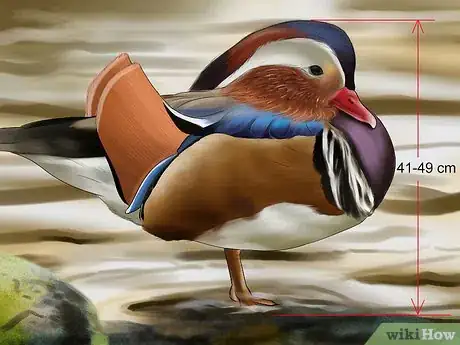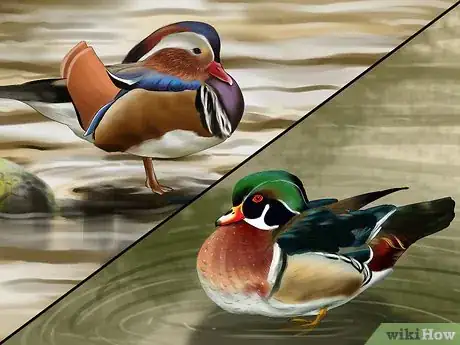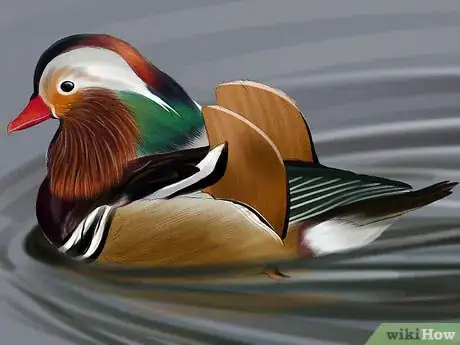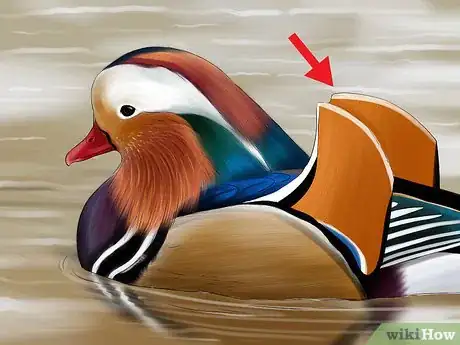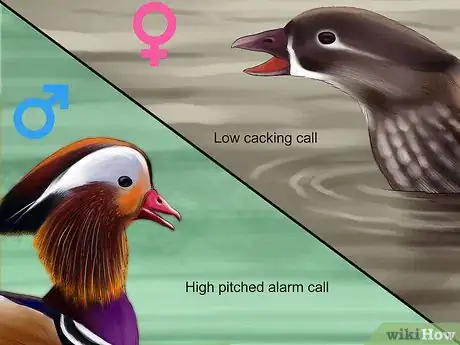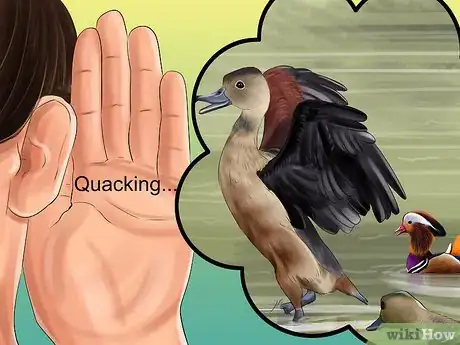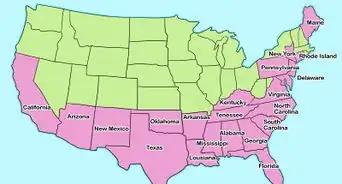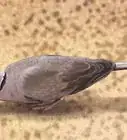X
wikiHow is a “wiki,” similar to Wikipedia, which means that many of our articles are co-written by multiple authors. To create this article, volunteer authors worked to edit and improve it over time.
There are 7 references cited in this article, which can be found at the bottom of the page.
This article has been viewed 29,019 times.
Learn more...
The beautiful feathered mandarin duck (Aix galericulata) is easy to tell apart from other ducks, once you know what to look for.
Steps
Method 1
Method 1 of 2:
By Appearance
-
1Learn to tell the difference between a male and a female mandarin duck. Male mandarin ducks are colourful to attract females, but the females are speckled white near their undersides with a stripe going across their neck.
- Female mandarin ducks are hard to identify when there are large amounts of other duck species, so look out for a female with a male instead.
- Young female mandarin ducks look like large chicks, and young males look long necked like a grebe, with a mostly brown body with a few flecks of green and blue.
-
2Observe the most distinctive colourings of males and females.[1] On males, look out for the white patch around their eye and a crest of green or purple on the top of their heads. On females, look out for the white neck stripe and the brown and white speckled area near their undersides.[2]
- In summer, the male looses all of his colour except a triangle of green near the tail and his beak colour. He then resembles the female duck.[3]
- The female duck will not change colour at all, unlike the male.
Advertisement -
3Look out for a 'ramp-shaped' bill with a flat bottom. Unlike many other birds, the ramp shape ends in a sharp yellow point. If you look closely, you will see that it curves down slightly at the end.
- The bill will either be coloured brown or bright red. A male's bill is bright red and a female's bill is brown.
- The bill looks a little like an albatross's, but it is thinner and less curved with a smaller sharp tip at the bottom.
-
4Look out for a medium-sized bird with a slight 'slouch' where their neck meets their body. They are generally about 41-49 cm (16.14-19.29 inches) tall[4] , which is about 10 cm smaller than most other duck species.
- Note that the female has a slightly longer and more distinguishable s shaped neck, unlike the male's, which is hidden by feathers.
- The baby mandarin ducks are like chicks; they hardly have a neck at all, but if you look closely, you can see a slight s shape like the adult female's.
-
5Learn to tell the difference between a male mandarin duck and a wood duck. The wood duck has an orange eye, and the male mandarin duck has a black eye. The wood duck does not have the same 'patchwork quilt' pattern on its feathers, and their heads are completely green, unlike the colourful head of a male mandarin duck.[5]
- Sometimes the wood duck will have a fleck of white on its head, but the male mandarin duck can still be separated from a wood duck by looking at the colourful head.
- A female mandarin duck and female wood duck can easily be determined from each other. The female wood duck has a small fleck of purple which the female mandarin duck does not have, and the patch around the eye is a circle of white instead of a stripe.
-
6Spot the shapes of colour on a male mandarin duck. On the body, the different colours are in triangles and stripes, rather than random shapes or rectangles like other duck species. This is an easy way a male can avoid being mistaken for another duck species such as a wood duck.
- This excludes the tail feather colours, which are in long triangles that are green or white.
- Some of the feathers overlap. Do not mistake these bumpy bits for circular shapes of one colour.
-
7Look out for the 'sails' that mandarin ducks have. They are two big circular shaped feathers that you can find on mandarin ducks. They stick up slightly like a boat sail, which is why people sometimes call them 'sails.'[6]
- These are 3/4 of the way along their bodies on male mandarin ducks, and absent on female mandarin ducks.
- The 'sail' feathers are coloured peach, brown or orange on male mandarin ducks, and sometimes they have a little white stripe at the top.
Advertisement
Method 2
Method 2 of 2:
By Sound
-
1Listen for the mandarin duck's calls. The male mandarin duck will make a shrill, high pitched alarm-like call, but the females will make a low cackling call.[7]
- These calls are usually made while the mandarin duck is in flight to alert the other mandarin duck that there is danger close by.
- Although the male mandarin duck's call is high pitched, both sexes' calls are quiet compared to other duck's, and they do not usually make the regular quacking noise.
-
2Set up a camera and tripod. You can record the sounds that you hear and look back to see if you have managed to get a clear recording of a mandarin duck call. It is easier to try to record the male's clear and shrill call rather than the female's.
- You can listen to recordings online to get a rough outline of what a mandarin duck's call sounds like.
- While recording, look out for mandarin ducks flying overhead. The calls are usually made in flight.
-
3Occasionally listen around for the traditional 'quacking' noises made by ducks. When they do quack, the sound can be heard clearly.
- Even if the quack is not made by a mandarin duck, it will indicate that there are ducks in the area, and more often than not, there are multiple duck species in a big group.
Advertisement
Community Q&A
-
QuestionHow is a baby Mandarin duck different from a chick? They are very similar in appearance.
 LilyTop AnswererChicks have more black on them. Look out for the distinctive black eye stripe and fluffy black bodies.
LilyTop AnswererChicks have more black on them. Look out for the distinctive black eye stripe and fluffy black bodies. -
QuestionDoes a female Mandarin duck have a slight green patch on top of her head?
 Kam JamCommunity AnswerA female Mandarin duck does not, but a male Mandarin duck does. The females are mostly brown, the males are the colorful ones.
Kam JamCommunity AnswerA female Mandarin duck does not, but a male Mandarin duck does. The females are mostly brown, the males are the colorful ones.
Advertisement
References
- ↑ http://wildpro.twycrosszoo.org/S/0AvAnserif/anatidae/1ACrAvAn_aix/Aix_galericulata/Aix_galericulata.htm
- ↑ http://www.birdfieldguide.co.uk/Mandarin_Duck.html
- ↑ https://www.livingwithbirds.com/tweetapedia/21-facts-on-mandarin-duck
- ↑ https://uk.whatbird.com/obj/1259/identification/Mandarin_Duck.aspx
- ↑ https://www.bto.org/about-birds/bird-id/identifying-mandarin-and-wood-duck
- ↑ http://www.canaryzoo.com/bird%20specie%20mandarin%20duck.htm
- ↑ https://luontoportti.com/en/t/1653/mandarin-duck
About This Article
Advertisement
